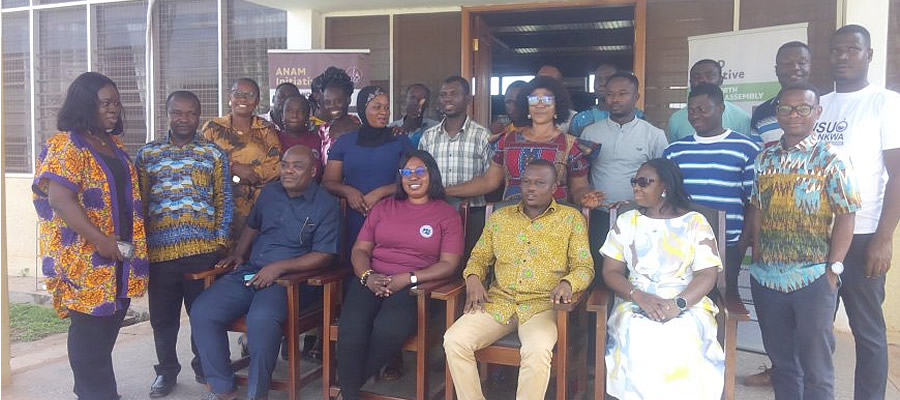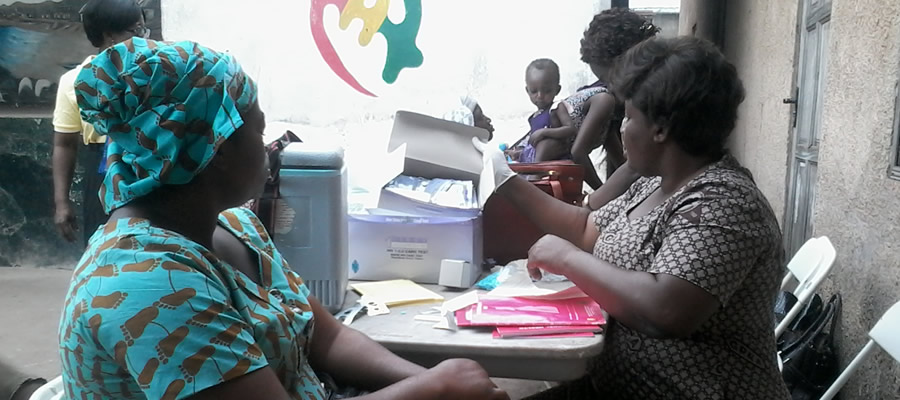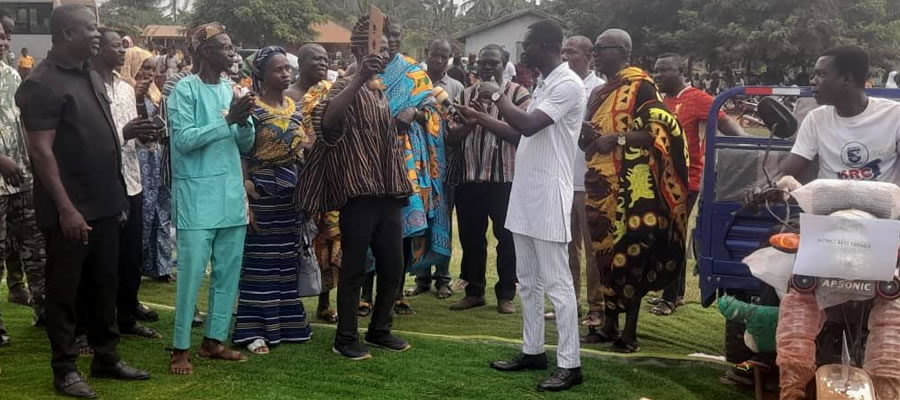

Service and Commerce
The main commercial activity in the District is buying and selling of agricultural and manufactured (industrial) goods. This forms an important activity to the people of the District. The major marketing centres in the District are Kenyasi, Gambia No. 2 and Ntotroso, Traders are mostly retailers who buy on market days and in turn sell it during non-market days.
Some of the agricultural goods that are traded include yams, plantain, cassava, fruits such as pea and oranges, cereals such as maize and rice. Industrial goods that are traded in are farm implements, plastics, footwear, textiles, used clothing, provisions and other manufactured goods. These goods are brought into the market centers from places such as Kumasi, Goaso, Tepa, and Sunyani.
Mining
The economic or investment potentials of Newmont Ghana Gold Limited, Ahafo Mine at Kenyasi, the District capital has opened up the area to people. The project was initiated in 2004 with exploration in 2005. The full operation of the gold mining activities which started a decade ago is having a greater impact on development as jobs have been created, revenue generated to the Assembly and social responsibility is being undertaken in these areas to complement the effort of the Assembly in the provision of basic services such as school blocks and water facilities. Again, the provision of alternative livelihood jobs in the catchment areas has also helped to create jobs and diversify the local economy. There are also activities of small-scale mining operators in these gold deposited areas which is a source of worry to the people although it serves as employment to the people.
The activities of these mines would be closely monitored to avoid any environmental hazards caused by their operations.
Manufacturing
The Manufacturing sector is one of the fastest growing local economy which employs 5.7%. The District can boast of small scale or ago-based industries like palm oil extraction, ‘gari’ processing, mechanical workshops, and a host of others in many other communities. There are other small-scale sectors such as wood-based industries (carpentry), metal works, block moulding and metal-based industries are mostly blacksmithing which are scattered in the District.
Apart from relying on unpaid apprentices, entrepreneurs in these industries employ few people to facilitate the production processes. The average size of small scale manufacturing in terms of members is about three people and in the case of medium scale, it is about ten people in the District.
Labour-intensive methods are used by entrepreneurs in most of the production processes, except in some few cases where chemical (petrol, diesel) and electric energies are used.
Through various interventions, the drudgery associated with Gari production has been eliminated in some pilot communities through the supply of gari-processing machines. Most production processes are financed through personal savings and support from relatives and friends. The main problems inhibiting the growth of the manufacturing industries are access to credit; small market size for products. In spite of the factors militating against growth in the sectors, manufacturing industries have the prospects to:
- Generate employment and improving income level for the rural people
- Utilise local raw materials and thereby provide market for agricultural produce
- Improve growth and development.
The sector must be encouraged to play a more meaningful role in the District Economy.
Construction
The construction sector in the District has seen a little improvement for decade or the past. The discovery of gold in the District coupled with increase in migration trends has boosted the construction industry. Construction works such as private houses, hotels, fuel stations along Kenyasi-Kumasi roads and a block laying factory are springing up. The high cost of building materials and high labour cost is seriously affecting this sub-sector. Despite this constraint the construction sector is one of the sub-sectors in terms of the attraction of jobs for the youth and the unemployed. The improvement in this sub-sector is likely to improve the incomes of the youth and improve the revenue base of the Assembly through property rate payment.
Energy
The District energy sources are analysed on the basis of electricity, fuel wood, petroleum products such as petrol, diesel oil and liquefied petroleum gas, solar, flashlights/torch and so on. It is estimated that 47.7% of the inhabitants now enjoy electricity from the National grid. This is due to the Government policy of the Rural Electrification Project known as Self Help Electrification Projects (SHEP).There are still quite a number of communities in the District that have not been connected to the National grid and others are yet to be connected to the National grid.
The major problem facing the District electricity production is the intermittent and unreliable nature of the power supply which affects production activities. With the improved economic activities and massive expansion and development springing up in the District, it has become necessary for the District to own its own sub-station to ensure regular supply of electricity.
Fuel wood and charcoal continue to be a major source of energy supply for cooking for the people in the District. The environmental threat caused by the cutting down of these trees and their effect on the depletion of the environment continue to be of great concern to the assembly.
POCC Analysis
The Analysis of Potentials, Opportunities, Constraints and Challenges (POCC)
This section focuses on the Potentials, Opportunities, Constraints, and Challenges (POCC) analysis in relation to the 201402017 Medium Term Development Policy Framework (MTDPF). The Potentials are the resources within the reach of the District which could be harnessed to augment the developments in the District. The Opportunities are other external factors that the District can take advantage of in enhancing the pace of development.
The constraints are the weaknesses from within which impede development steps have to be taken internally to address them. The Challenges are external constraints hampering development which needs to be overcome. The POCC analysis under the 2014-2017 Medium Term Development Policy Framework themes are analysed in table 2.3.
District Finance
Local Government Finances (2003–2005)
This section deals with the analysis of the revenue and expenditure pattern of the District Assembly from 2003-2005, with the view of identifying areas that need intervention for the overall development of the district.
Finance has become a prominent issue at the local level following the decentralization process where District Assemblies now have the responsibility to plan and implement their own projects or programmes. The need to make an analysis of the financial situation in the Asutifi District is therefore imperative.
This analysis looks at the major sources of revenue to determine how the district has been performing over the years with respect to revenue mobilization and generation. The variation between revenue and expenditure is also worth studying.
Revenue Performance
The Asutifi District largely depends on internal sources for the day-to-day running of the district administration. These include revenue that accrues as a result of its own effort at revenue mobilization and generation. These include rates and receipts, royalties from lands, fees and tolls, licenses, rent, investments and other miscellaneous activities. Externally, revenue also comes to District Assembly from the Central and Local Governments in the form of Grant-in-aid and the District Assemblies’ Common Fund.
It must be pointed out that absolute figures have not been discounted for the real changes of the budget and where necessary percentages have been used to reflect changes and for ease of comparison. On the whole, the basic assumption for the analysis is that changes in the budget over the years are a reflection of inflationary changes experienced in the country over the period. The general performance of revenue collection has been satisfactory as indicated on the matrix at the totals row. From 2003-2004, there have been a percentage increase of 50% and 51.6% from 2004 to 2005 which is good news. However more needs to be done to improve the revenue situation as the individual revenue sources performance have not been all that satisfactory as discuss below:
From a critical analysis of the matrix above it can be seen that revenue from Rates, Lands and Miscellaneous have increased from 2003 through 2004 to 2005 whilst that of Fees/Fines, Licenses and Investments rise and fell with Rents experiencing continues decline throughout the three (3) year period.
In 2003 for instance, Lands ranked 1st on the table contributing more to revenue with a substantial amount of the money coming from Stool Lands and Concessions.
This implies that revenue mobilization on Stool Lands and Concessions should be intensified and security tightened at the district borders since there are high potentials of generating more revenue from there. Closely followed by Lands is miscellaneous ranking 2nd in 2004, 2005 and 3rd in 2003. A greater amount of this source of revenue comes from unspecified receipts and donations. This shows that more efforts should be made to organize programmes geared towards revenue mobilization and vigilantes improved in those areas where enough has not been done.
The other sources of revenue which include Licenses did so well in 2003 with the greatest contribution coming from Building Contractors as indicated in the table below. It however fell in 2004 even though that was an improvement over 2003 figure. This calls for intensification of security and appropriate sanctions spelt out for people who do not pay the appropriate taxes. Fees and Fines which rank 3rd in general terms gave the highest revenue in 2005, second in 2003 with 2004 recording the lowest. The calls for adequate security and vigilance at the various borders since conveyance of foodstuffs and market tolls contributed the highest revenue to Fees/Fines. Moreover the tax net on Rent needs to be broadened and strategies put in place to ensure their collection since its performance on revenue is very low especially in the area of market Stores/Stalls. More savings is needed to improve the revenue base of the Assembly through investment. This can only be achieved if the Assembly is able to cut down its expenditure.
Revenue Mobilization Problems
Some internal problems that need to be addressed in order to further improve upon revenue generation include:
- Inability of some Assembly Members to help educate their electorates on the need to pay taxes
- Lack of commitment of some Revenue Staff.
- Rampant evasion of tax payment.
- Mal-practices in the issuance of tickets and receipts.
- Non-prosecution of rate-defaulters
- Low income levels of the population
- Poor performance of Revenue Task Force.
- Inability of Town / Area Councils to collect ceded revenue items
Measures to Ensure Sound Financial Management Practices in the District
Management has put in place stringent measures annually to ensure sound financial management practices in the district in terms of cash inflows and outflows. At the end of each financial year, a budget is prepared to ensure that the District Assembly operates within these budgeted figures in compliance with the mandate given by the District Assembly. To ensure efficiency, a revenue mobilization Task Force has been formed to visit all revenue station to help mobilize revenue. They make sure that all monies collected are banked to check fraudulent deals in handling cash.
Income and Expenditure
Monthly Income Distribution
From the survey conducted, the monthly income distribution is skewed towards the urban areas especially the mining communities. This could be explained by the fact that in most of these urban and mining areas, there are Government officials and other salaried workers who earn incomes on monthly basis. In the rural areas, their incomes are mostly from crop production which is seasonal and hence cannot easily account for the amounts they earn on monthly basis.
Expenditure Types
The leading area of household spending is feeding. It represents 59 per cent followed by energy 13 per cent, transport 10 per cent, education 8 per cent, health 3 per cent, funerals 4 per cent and housing 3 per The Ghana Living Standard Survey (2010) put the estimate on food spending at 63 per cent. Expenditure on food in the District, therefore, falls below the National average. This could be attributed to the fact that it is a food crop growing area and almost all the farmers concentrate on subsistence agriculture.
The average income per month for a household is about ¢202,553.75 with a monthly expenditure of about ¢208,753.00. About 60% of this household income is spent on food. Compared with the National minimum wage of ¢214,500 per month (year 2002 figure) and using expenditure as basis for assessing gross income, it can be seen that the average income levels in the District is quite fair. The problem, however, is the inequalities in the distribution of income in the District. It is sad to note that some food crop farmers receive as low as ¢29,000.00 per month as income. It is worth noting that expenditure level have increase in sections of the District (mine take area) where prices of goods and services have increased due to the influx of people from all over the country into the area to work or seek for jobs.
Generally, the standard of living of the people is low especially in the non-mining areas. About 48.9% of the people live below the poverty line. The people’s access to basic facilities and services is limited, and this account for their inability to contribute meaningfully to development. The people earn very little and cannot therefore save to build capital for development.
It is realised from the survey that, the upper 20 per cent of the households in the District controls 60 percent of the income in the District, while the lower 25% controls as little as 4% of the income.
Financial Institutions
Financial Services
Banking
There are a number of financial services in the district. The banks operating in the district include:
- EcoBank at Kenyasi No. 1,
- Agricultural Development Bank (ADB) at Kenyasi No. 1,
- Ghana Commercial Bank at Hwediem,
- Tano Rural Bank at Ntotroso (with branches at Kenyasi No. 1 & Gambia No. 2),
- Tano Agya Rural Bank at Kenyasi No. 2 and Dadiesoaba,
- Asutifi Rural Bank at Acherensua (with a branch at Kenyasi No. 2),
- Ahafo Community Bank at Hwediem and Kenyasi No. 1.
These banks give loans, credit and overdraft to most of their customers but according to most of the customers they find it very difficult to secure loans from their bankers. The bankers on the other hand contend that their customers are not able to provide either the necessary collateral security or guarantors in order to obtain the loans. If properly patronized, farmers, traders and other business operators would find it easy to attract loans in order to expand their businesses.
Other Financial Institutions
Apart from the banking sector, which deals with monetary transactions, there are other institutions, which help the citizenry to mobilize funds and also to deal with their financial needs in times of trouble. There are community based credit unions, insurance companies and susu collectors in the district. Most of these institutions offer loans and credit to their customers who feel more secured than the orthodox banking services.
Private Sector
Private Sector Competitiveness
Private economic and political thinking that favours private sector initiatives as a solution to deteriorating economic and employment problems point to the need for developing enterprises and self-employment.
Asutifi is one such District that recognizes the potential of the private sector as becoming the engine of growth. Furthermore, both the urban and rural areas of the District have major problems affecting national productivity and development. Among our proposed strategies are:
- Promoting and increasing access to technology, credit and economic services especially to rural and urban informal sectors.
- Promoting and supporting the informal sectors and cooperatives.
- Improving marketing linkages in the agricultural sector
- Improving access to entrepreneurial training
- Improving Public-Private sector dialogue
- Strengthening capacities of trade organizations for the provision of Business Development services
The industries identified in the District could be described as micro and small scale or cottage industries. Most establishments in the District were setup through the proprietors’ own resources or through financial assistance from family and relations. For others, high interest rates charged and demand for collateral security discouraged or prevented them from securing loans from the established financial institutions.
The level of industrialisation in the District is low considering the type of ownership and management, low volumes of production, levels of investment and lack of access to formal credit. Some of the enterprises have no registered names since most of them were informal operators. The enterprises are engaged in agro-processing, wood, metal, alcoholic beverages and services.
Skills Training
The District Assembly is engaged in fruitful interventions to increase productions in all sectors of the economy in order to enhance gainful employment of the teeming masses of the District.
This is in line with the current government policy of wealth creation and the development of the private sector as the mover of the economy. This portion discusses the major sectors that employ the bulk of the people in skills training in the District.
The Rural Enterprises Project, which is based in district, is designed to sustain the Government of Ghana’s economic reforms by combining the adjustment process with programmes generating efficient employment in the private productive sectors. The overall objective of the project is to increase the incomes of the rural poor and to meet the needs of agricultural producers for inputs and services. This objective is being achieved by;
- facilitating access to technical services and business advice;
- providing easy access to financial facilities; and
- improving the efficiency of existing small rural enterprises and supporting new initiatives in suitable small scale enterprises.
The Ahofo Agri-business Initiative (AAGI) being sponsored by Newmont Ghana Gold is also offering skills training to inhabitants of the mine take areas.
Date Created : 11/14/2017 6:58:31 AM












 facebook
facebook
 twitter
twitter
 Youtube
Youtube
 +233 593 831 280
+233 593 831 280 0800 430 430
0800 430 430 GPS: GE-231-4383
GPS: GE-231-4383 info@ghanadistricts.com
info@ghanadistricts.com Box GP1044, Accra, Ghana
Box GP1044, Accra, Ghana